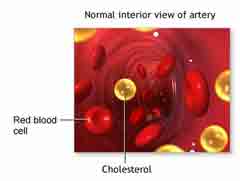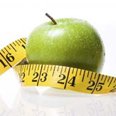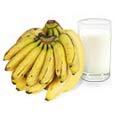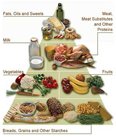|
Cholesterol and its Effect on Healthage-well.org > prevent age related diseases > prevent cholesterol By Mirella Levin
Regarding cholesterol, fiber takes it out of the digestive health, helps take toxins out of the system and generally helps the system to function.
What is Cholesterol?
Cholesterol is a fatty, pearl like alcohol (molecular formula of C27H460). This substance, which is located in the blood stream, is necessary for life. It helps build and maintain cell membranes and is useful for hormone production. However, there are many negative effects to having too much. This can be from either dietary resources or from the liver where it is produced. In fact, the liver can either produce or absorb it. After intake (from a dietary source) the liver will absorb it from the blood stream. However, in between meals, the liver will produce and secrete it back into the blood stream. This substance can be found in many places. It can be found in any animal fats and oils. However, in the human body, it can be found in the bile, the blood, brain tissue, liver, kidneys and the adrenal glands. It can also be found in many other foods, such as egg yolk, milk or any type of meat.
LDL Cholesterol (Low density lipoprotein)This is known as the bad type. It has been shown that high levels of LDL can contribute to Coronary Heart Disease. This is because, whilst being transported in the blood, it will stick to the blood vessel’s walls, causing them to narrow. In the arteries, it will harden and plaque (a thick substance that blocks the arteries) will be formed. As the plaque increases the artery walls become narrower. This process is known as atherosclerosis which can lead to Heart Disease. Elevated levels of LDL are usually a result of eating too many foods containing high amounts of saturated or Trans fats. Saturated fats are found mainly in foods such as fatty meats, milk, cheese and butter. Trans Fats however, are most commonly found in dairy products and certain meats such as beef or lamb. Reducing the levels of LDL can lead to many health benefits such as the decrease in risk of Heart disease, heart attacks and strokes. HDL Cholesterol (High density lipoprotein)This is known as the good type because the particles of this type remove the plaque that has been deposited in the artery walls. It is then broken down in the liver. Therefore, this type will prevent the process of atherosclerosis and it will help prevent the occurrence of Heart Disease. HDL cholesterol can also have anti-inflammatory, antioxidant and ant-clotting effects in the body. Maintaining a healthy level of cholesterolBecause cholesterol is essential we cannot eliminate it entirely from our diets. We need to figure out what amount is needed without there being any negative side effects. For HDL (the good type) the goal should be to have a high dose. For both males and females, the average HDL should be around 60 mg/dl (milligrams per deciliter of blood). Below (table 1), we can see that by increasing your levels of HDL, the risk of Heart Disease is lowered.
Table 1
**mmol/L = millimoles per liter (Source: Mayo Clinic: How to Boost your Good Cholesterol - see http://www.mayoclinic.com/health/hdl-cholesterol/CL00030))How to decrease LDL levelsOne of the ways to lower the levels of the bad typel in the blood is to eat certain foods. These include oatmeal or oat bran which contain fiber. Walnuts and almonds can also help because these polyunsaturated fatty acids help maintain healthy blood vessels. Fish can reduce LDL levels thanks to its rich Omega-3 fatty acids. These can be found in trout, herring, sardines, tuna etc. Olive oil, which contains antioxidants, will lower LDL levels without harming the HDL ones. Eating foods with polyunsaturated or mono-unsaturated fats instead of foods containing saturated fats will reduce LDL levels which can lead to a better and healthier life. How to increase HDL levels
Latest News Items on Cholesterol
Cholesterol news headlines provided courtesy of Medical News Today.
age-well.org > prevent age related diseases > prevent cholesteral TOP of Cholesterol |
Subscribe to Age-well.org Ezine
Eat Well
Table of Contents
Eat-Well-Homepage

- Water
- Antioxidants
- Chocolate
- Caffeine
- Cherries
- Cranberries
- Maquiberries
- Salt
- Sugar
- Cholesterol and its Effect on Health
- Fruit & Vegetables - Fresh Versus Frozen or Canned
- Nuts, Beans and Pulses
- Monosodium Glutamate (MSG)
- Unsaturated Fats - The Right Fats for Health
- What are Transfats?
- Water
- 20 Benefits of Drinking Enough Water



All About Vitamins and Minerals










